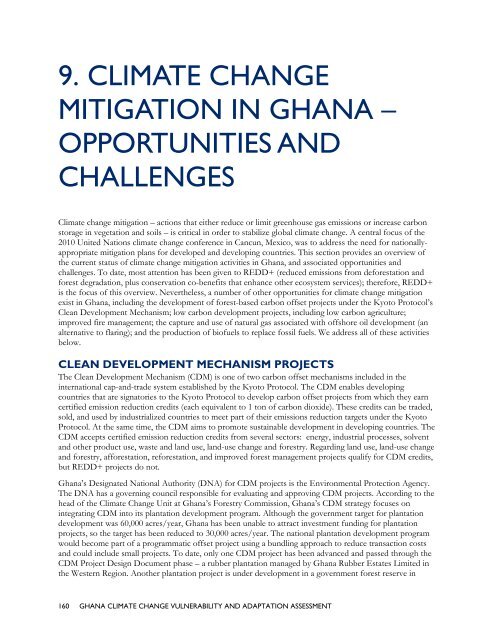ghana climate change vulnerability and adaptation assessment
ghana climate change vulnerability and adaptation assessment
ghana climate change vulnerability and adaptation assessment
- No tags were found...
You also want an ePaper? Increase the reach of your titles
YUMPU automatically turns print PDFs into web optimized ePapers that Google loves.
9. CLIMATE CHANGEMITIGATION IN GHANA –OPPORTUNITIES ANDCHALLENGESClimate <strong>change</strong> mitigation – actions that either reduce or limit greenhouse gas emissions or increase carbonstorage in vegetation <strong>and</strong> soils – is critical in order to stabilize global <strong>climate</strong> <strong>change</strong>. A central focus of the2010 United Nations <strong>climate</strong> <strong>change</strong> conference in Cancun, Mexico, was to address the need for nationallyappropriatemitigation plans for developed <strong>and</strong> developing countries. This section provides an overview ofthe current status of <strong>climate</strong> <strong>change</strong> mitigation activities in Ghana, <strong>and</strong> associated opportunities <strong>and</strong>challenges. To date, most attention has been given to REDD+ (reduced emissions from deforestation <strong>and</strong>forest degradation, plus conservation co-benefits that enhance other ecosystem services); therefore, REDD+is the focus of this overview. Nevertheless, a number of other opportunities for <strong>climate</strong> <strong>change</strong> mitigationexist in Ghana, including the development of forest-based carbon offset projects under the Kyoto Protocol’sClean Development Mechanism; low carbon development projects, including low carbon agriculture;improved fire management; the capture <strong>and</strong> use of natural gas associated with offshore oil development (analternative to flaring); <strong>and</strong> the production of biofuels to replace fossil fuels. We address all of these activitiesbelow.CLEAN DEVELOPMENT MECHANISM PROJECTSThe Clean Development Mechanism (CDM) is one of two carbon offset mechanisms included in theinternational cap-<strong>and</strong>-trade system established by the Kyoto Protocol. The CDM enables developingcountries that are signatories to the Kyoto Protocol to develop carbon offset projects from which they earncertified emission reduction credits (each equivalent to 1 ton of carbon dioxide). These credits can be traded,sold, <strong>and</strong> used by industrialized countries to meet part of their emissions reduction targets under the KyotoProtocol. At the same time, the CDM aims to promote sustainable development in developing countries. TheCDM accepts certified emission reduction credits from several sectors: energy, industrial processes, solvent<strong>and</strong> other product use, waste <strong>and</strong> l<strong>and</strong> use, l<strong>and</strong>-use <strong>change</strong> <strong>and</strong> forestry. Regarding l<strong>and</strong> use, l<strong>and</strong>-use <strong>change</strong><strong>and</strong> forestry, afforestation, reforestation, <strong>and</strong> improved forest management projects qualify for CDM credits,but REDD+ projects do not.Ghana’s Designated National Authority (DNA) for CDM projects is the Environmental Protection Agency.The DNA has a governing council responsible for evaluating <strong>and</strong> approving CDM projects. According to thehead of the Climate Change Unit at Ghana’s Forestry Commission, Ghana’s CDM strategy focuses onintegrating CDM into its plantation development program. Although the government target for plantationdevelopment was 60,000 acres/year, Ghana has been unable to attract investment funding for plantationprojects, so the target has been reduced to 30,000 acres/year. The national plantation development programwould become part of a programmatic offset project using a bundling approach to reduce transaction costs<strong>and</strong> could include small projects. To date, only one CDM project has been advanced <strong>and</strong> passed through theCDM Project Design Document phase – a rubber plantation managed by Ghana Rubber Estates Limited inthe Western Region. Another plantation project is under development in a government forest reserve in160 GHANA CLIMATE CHANGE VULNERABILITY AND ADAPTATION ASSESSMENT
















